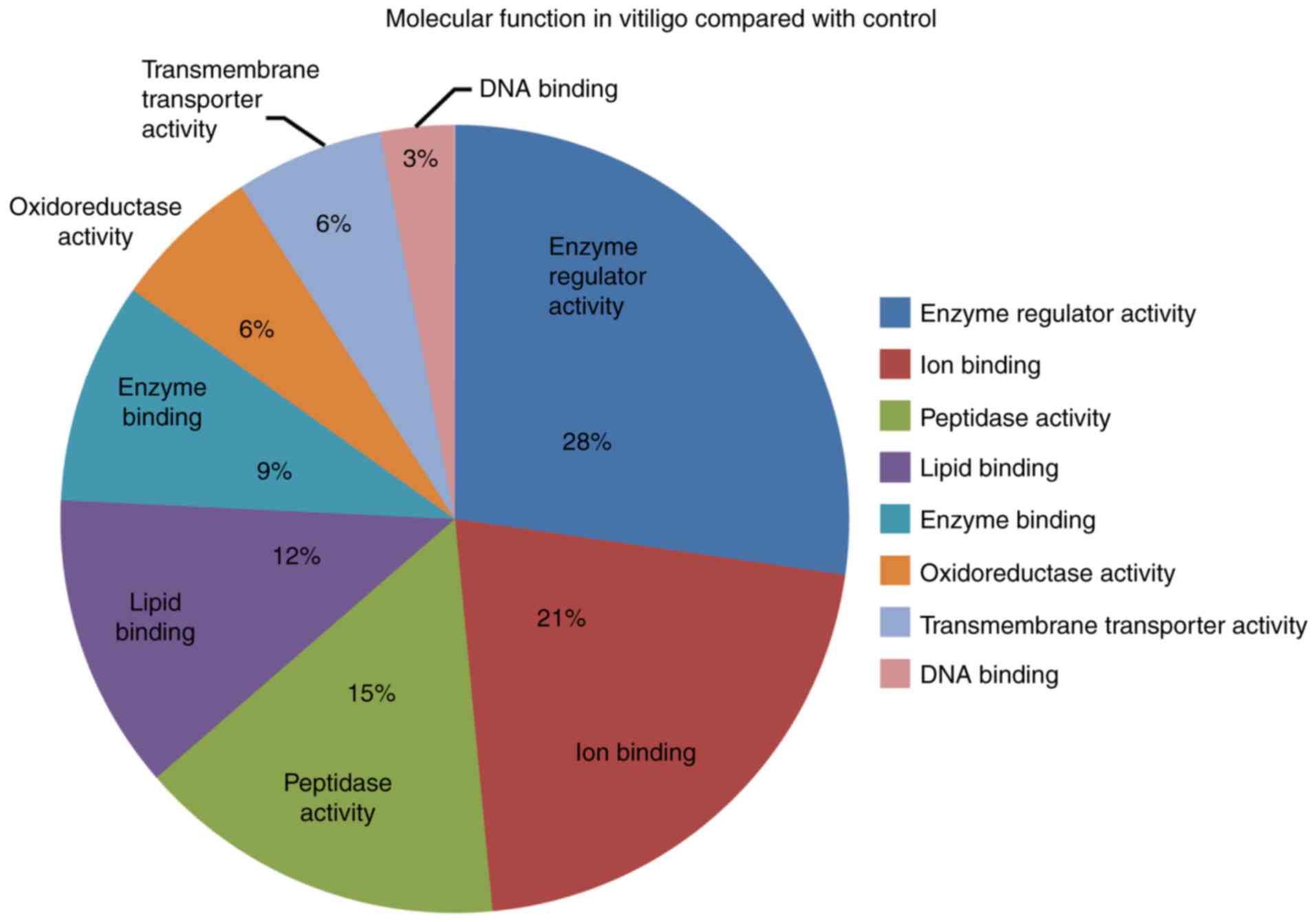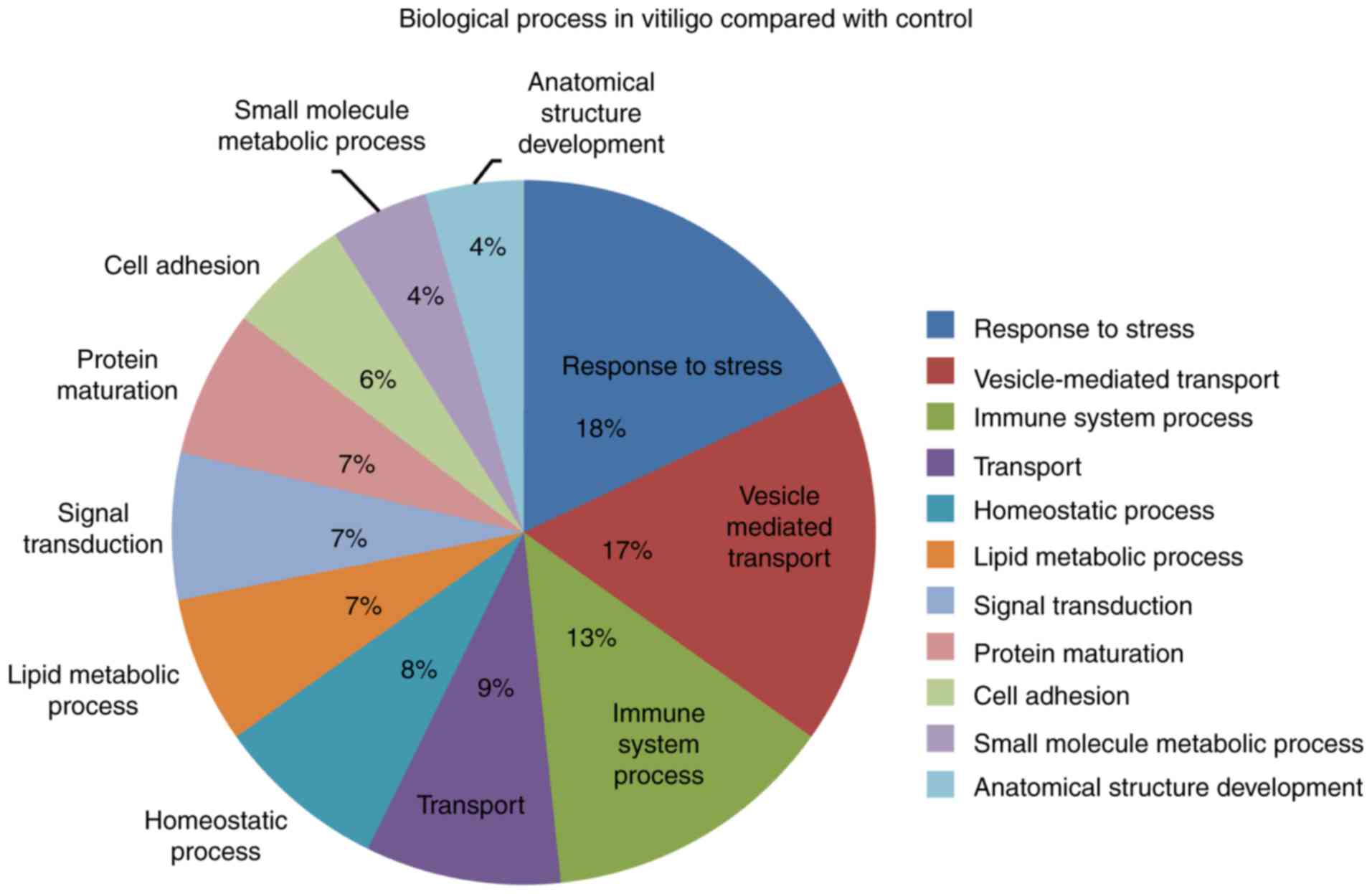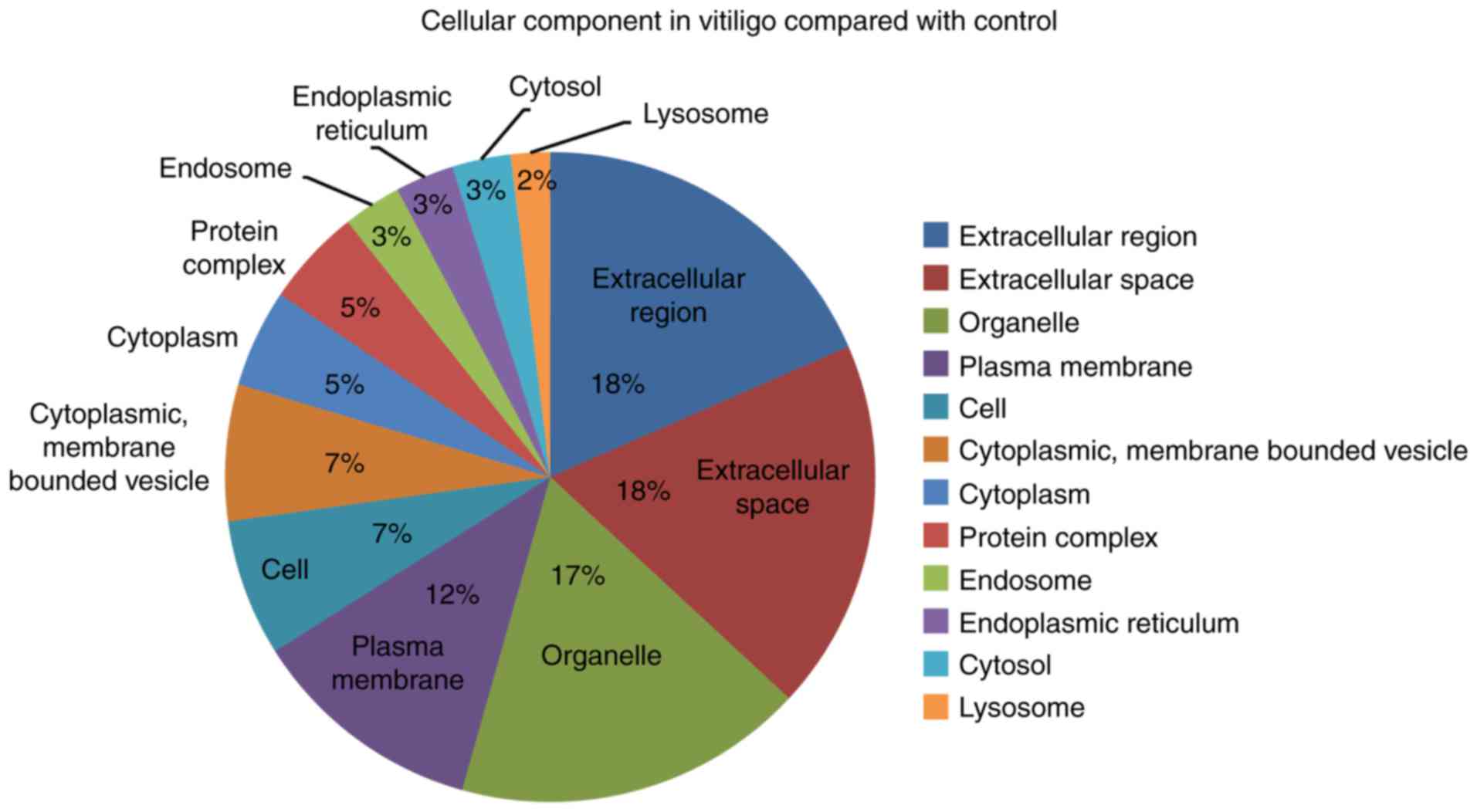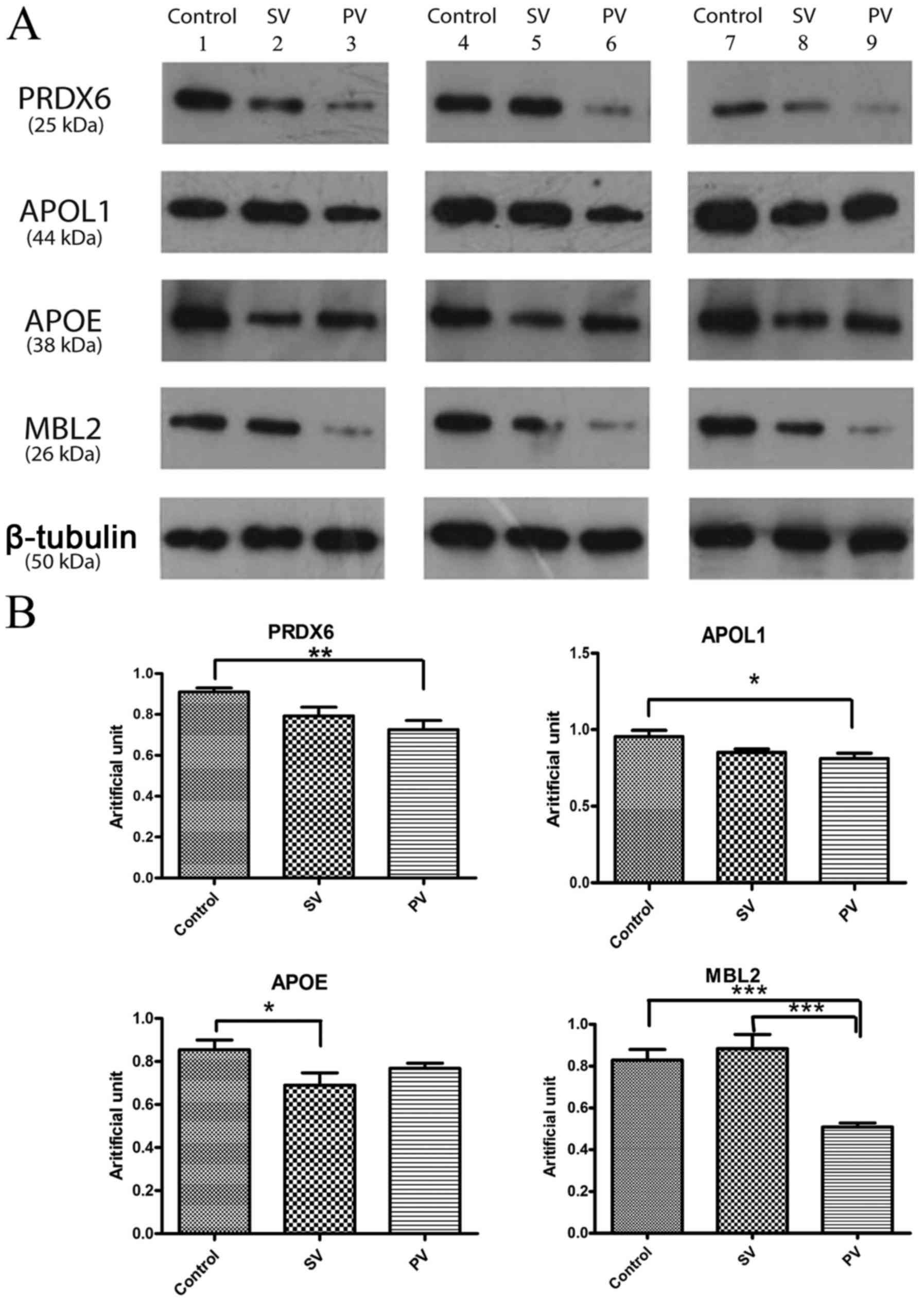|
1
|
Isenstein AL, Morrell DS and Burkhart CN:
Vitiligo: Treatment approach in children. Pediatr Ann. 38:339–344.
2009. View Article : Google Scholar : PubMed/NCBI
|
|
2
|
Guerra L, Dellambra E, Brescia S and
Raskovic D: Vitiligo: Pathogenetic hypotheses and targets for
current therapies. Curr Drug Metab. 11:451–467. 2010. View Article : Google Scholar : PubMed/NCBI
|
|
3
|
Birlea SA, Fain PR and Spritz RA: A
Romanian population isolate with high frequency of vitiligo and
associated autoimmune diseases. Arch Dermatol. 144:310–316. 2008.
View Article : Google Scholar : PubMed/NCBI
|
|
4
|
Shin J, Kang HY, Kim KH, Park CJ, Oh SH,
Lee SC, Lee S, Choi GS and Hann SK: Involvement of T cells in early
evolving segmental vitiligo. Clin Exp Dermatol. 41:671–674. 2016.
View Article : Google Scholar : PubMed/NCBI
|
|
5
|
Wang XX, Wang QQ, Wu JQ, Jiang M, Chen L,
Zhang CF and Xiang LH: Increased expression of CXCR3 and its
ligands in patients with vitiligo and CXCL10 as a potential
clinical marker for vitiligo. Br J Dermatol. 174:1318–1326. 2016.
View Article : Google Scholar : PubMed/NCBI
|
|
6
|
Richmond JM, Bangari DS, Essien KI,
Currimbhoy SD, Groom JR, Pandya AG, Youd ME, Luster AD and Harris
JE: Keratinocyte-derived chemokines orchestrate T-Cell positioning
in the epidermis during vitiligo and may serve as biomarkers of
disease. J Invest Dermatol. 137:350–358. 2017. View Article : Google Scholar : PubMed/NCBI
|
|
7
|
Speeckaert R, Lambert J, Grine L, Van Gele
M, De Schepper S and van Geel N: The many faces of interleukin-17
in inflammatory skin diseases. Br J Dermatol. 175:892–901. 2016.
View Article : Google Scholar : PubMed/NCBI
|
|
8
|
Guan M, Chen X, Ma Y, Tang L, Guan L, Ren
X, Yu B, Zhang W and Su B: MDA-9 and GRP78 as potential diagnostic
biomarkers for early detection of melanoma metastasis. Tumour Biol.
36:2973–2982. 2015. View Article : Google Scholar : PubMed/NCBI
|
|
9
|
Kazemipour N, Qazizadeh H, Sepehrimanesh M
and Salimi S: Biomarkers identified from serum proteomic analysis
for the differential diagnosis of systemic lupus erythematosus.
Lupus. 24:582–587. 2015. View Article : Google Scholar : PubMed/NCBI
|
|
10
|
Group CAolMoDPCPDS, . Consensus of
Vitiligo Diagnosis and Treatment (2014 Edition). Chin J Dermatol.
47:652014.
|
|
11
|
Jin Y, Birlea SA, Fain PR, Ferrara TM, Ben
S, Riccardi SL, Cole JB, Gowan K, Holland PJ, Bennett DC, et al:
Genome-wide association analyses identify 13 new susceptibility
loci for generalized vitiligo. Nat Genet. 44:676–680. 2012.
View Article : Google Scholar : PubMed/NCBI
|
|
12
|
Alikhan A, Felsten LM, Daly M and
Petronic-Rosic V: Vitiligo: A comprehensive overview part I.
Introduction, epidemiology, quality of life, diagnosis,
differential diagnosis, associations, histopathology, etiology and
work-up. J Am Acad Dermatol. 65:473–491. 2011. View Article : Google Scholar : PubMed/NCBI
|
|
13
|
Vaccaro M, Cannavò SP, Imbesi S, Cristani
M, Barbuzza O, Tigano V and Gangemi S: Increased serum levels of
interleukin-23 circulating in patients with non-segmental
generalizedvitiligo. Int J Dermatol. 54:672–674. 2015. View Article : Google Scholar : PubMed/NCBI
|
|
14
|
Jian Z, Li K, Liu L, Zhang Y, Zhou Z, Li C
and Gao T: Heme oxygenase-1 protects human melanocytes from
H2O2-induced oxidative stress via the Nrf2-ARE pathway. J Invest
Dermatol. 131:1420–1427. 2011. View Article : Google Scholar : PubMed/NCBI
|
|
15
|
Rork JF, Rashighi M and Harris JE:
Understanding autoimmunity of vitiligo and alopecia areata. Curr
Opin Pediatr. 28:463–469. 2016. View Article : Google Scholar : PubMed/NCBI
|
|
16
|
Laddha NC, Dwivedi M, Mansuri MS, Singh M,
Gani AR, Yeola AP, Panchal VN, Khan F, Dave DJ, Patel A, et al:
Role of oxidative stress and autoimmunity in onset and progression
of vitiligo. Exp Dermatol. 23:352–353. 2014. View Article : Google Scholar : PubMed/NCBI
|
|
17
|
Wadhwa B, Relhan V, Goel K, Kochhar AM and
Garg VK: Vitamin D and skin diseases: A review. Indian J Dermatol
Venereol Leprol. 81:344–355. 2015. View Article : Google Scholar : PubMed/NCBI
|
|
18
|
Dammak I, Boudaya S, Ben Abdallah F, Turki
H, Attia H and Hentati B: Antioxidant enzymes and lipid
peroxidation at the tissue level in patients with stable and active
vitiligo. Int J Dermatol. 48:476–480. 2009. View Article : Google Scholar : PubMed/NCBI
|
|
19
|
Fisher AB: Peroxiredoxin 6 in the repair
of peroxidized cell membranes and cell signaling. Arch Biochem
Biophys. 617:68–83. 2017. View Article : Google Scholar : PubMed/NCBI
|
|
20
|
Shibata S, Shibata N, Shibata T, Sasaki H,
Singh DP and Kubo E: The role of Prdx6 in the protection of cells
of the crystalline lens from oxidative stress induced by UV
exposure. Jpn J Ophthalmol. 60:408–418. 2016. View Article : Google Scholar : PubMed/NCBI
|
|
21
|
Zha X, Wu G, Zhao X, Zhou L, Zhang H, Li
J, Ma L and Zhang Y: PRDX6 protects ARPE-19 cells from oxidative
damage via PI3K/AKT signaling. Cell Physiol Biochem. 36:2217–2228.
2015. View Article : Google Scholar : PubMed/NCBI
|
|
22
|
Zhou Q, Wang F, Zhang Y, Yang F, Wang Y
and Sun S: Down-regulation of Prdx6 contributes to DNA vaccine
induced vitiligo in mice. Mol Biosyst. 7:809–816. 2011. View Article : Google Scholar : PubMed/NCBI
|
|
23
|
Filou S, Lhomme M, Karavia EA,
Kalogeropoulou C, Theodoropoulos V, Zvintzou E, Sakellaropoulos GC,
Petropoulou PI, Constantinou C, Kontush A and Kypreos KE: Distinct
roles of apolipoproteins A1 and E in the modulation of high-density
lipoproteincomposition and function. Biochemistry. 55:3752–3762.
2016. View Article : Google Scholar : PubMed/NCBI
|
|
24
|
Fizelova M, Miilunpohja M, Kangas AJ,
Soininen P, Kuusisto J, Ala-Korpela M, Laakso M and Stančáková A:
Associations of multipie lipoprotein and apolipoprotein measures
with worsening of glycemia and incident type 2 diabetes in 6607
non-diabetic Finnish men. Atherosclerosis. 240:272–277. 2015.
View Article : Google Scholar : PubMed/NCBI
|
|
25
|
Simó R, García-Ramírez M, Higuera M and
Hernández C: Apolipoprotein A1 is overexpressed in the retina of
diabetic patients. Am J Ophthalmol. 147:319–325.e1. 2009.
View Article : Google Scholar : PubMed/NCBI
|
|
26
|
Meroufel DN, Mediene-Benchekor S,
Lardjam-Hetraf SA, Ouhaïbi-Djellouli H, Boulenouar H,
Hamani-Medjaoui I, Hermant X, Saïdi-Mehtar N, Amouyel P, Houti L,
et al: Associations of common SNPs in the SORT1, GCKR, LPL, APOA1,
CETP, LDLR, APOE genes with lipid trait levels in an Algerian
population sample. Int J Clin Exp Pathol. 8:7358–7363.
2015.PubMed/NCBI
|
|
27
|
Ikeda T, Shinohata R, Murakami M, Hina K,
Kamikawa S, Hirohata S, Kusachi S, Tamura A and Usui S: A rapid and
precise method for measuring plasma apoE-rich HDL using
polyethylene glycol and cation-exchange chromatography: A pilot
study on the clinical significance of apoE-rich HDL measurements.
Clin Chim Acta. 465:112–118. 2017. View Article : Google Scholar : PubMed/NCBI
|
|
28
|
Dai S, Wang B, Li W, Wang L, Song X, Guo
C, Li Y, Liu F, Zhu F, Wang Q, et al: Systemic application of
3-methyladenine markedly inhibited atherosclerotic lesion in
ApoE-/-mice by modulating autophagy, foam cell formation and
immune-negative molecules. Cell Death Dis. 7:e24982016. View Article : Google Scholar : PubMed/NCBI
|
|
29
|
Urquidi V, Goodison S, Ross S, Chang M,
Dai Y and Rosser CJ: Diagnostic potential of urinary α1-antitrypsin
and apolipoprotein E in the detection of bladder cancer. J Urol.
188:2377–2383. 2012. View Article : Google Scholar : PubMed/NCBI
|
|
30
|
Orsatti CL, Nahas EA, Nahás-Neto J,
Orsatti FL, Linhares IM and Witkin SS: Mannose-binding lectin gene
polymorphism and risk factors for cardiovascular disease in
postmenopausal women. Mol Immunol. 61:23–27. 2014. View Article : Google Scholar : PubMed/NCBI
|
|
31
|
Heitzeneder S, Seidel M, Förster-Waldl E
and Heitger A: Mannan-binding lectin deficiency-Good news, bad
news, doesn't matter? Clin Immunol. 143:22–38. 2012. View Article : Google Scholar : PubMed/NCBI
|
|
32
|
Swierzko AS, Szala A, Sawicki S, Szemraj
J, Sniadecki M, Sokolowska A, Kaluzynski A, Wydra D and Cedzynski
M: Mannose-binding lectin (MBL) and MBL-associated serine
protease-2 (MASP-2) in women with malignant and benign ovarian
tumours. Cancer Immunol Immunother. 63:1129–1140. 2014. View Article : Google Scholar : PubMed/NCBI
|
|
33
|
Çalkavur Ş, Erdemir G, Onay H,
AltunKöroğlu Ö, Yalaz M, Zekioğlu O, Aksu G, Özkınay F, Akercan F
and Kültürsay N: Mannose-binding lectin may affect pregnancy
outcome. Turk J Pediatr. 57:26–33. 2015.PubMed/NCBI
|
|
34
|
Pradhan V, Surve P, Rajadhyaksha A,
Rajendran V, Patwardhan M, Umare V, Ghosh K and Nadkarni A: Mannose
binding lectin (MBL) 2 gene polymorphism & its association with
clinical manifestations in systemic lupus erythematosus (SLE)
patients from western India. Indian J Med Res. 141:199–204. 2015.
View Article : Google Scholar : PubMed/NCBI
|
|
35
|
Onay H, Pehlivan M, Alper S, Ozkinay F and
Pehlivan S: Might there be a link between mannose binding lectin
and vitiligo? Eur J Dermatol. 17:146–148. 2007.PubMed/NCBI
|













